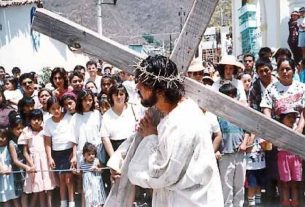The story begins in 1941, at the time America went to war with Japan and Germany. It concerns the Salazar family, poor farmers in Chihuahua. The grandfather, Sebastian, knows he is dying and he advises the family to move to the United States. He reasons that because of the war the Americans will want lots of people to work in their country as their men go off to fight. Their farm is a ruin. Only expensive fertilizer could bring it back to life. And they don’t have any money.
Sebastian dies and the entire family heads north – two sons, José Luis and Francisco – and their wives and children. The farm is worth $2,000 but they only get $400 for it. And that’s only the start of their bad luck.
On the way north they have an accident and one of the wives suffers a broken arm and damaged ribs. A mix-up with a U.S. contractor looking for Mexican workers splits up the group. José Luis goes with his family to El Paso. Francisco and his family go to Mission, Texas. At this point, however, it is agreed that once their combined fortunes are restored they will all return to Mexico.
For the first part of this interesting saga we follow José Luis’s family and mainly the progress of his teenage son, Miguel. Miguel has a couple of romances that come to nothing but leave him shattered. He also does badly in school because of his poor English.
Miguel’s older brother, Raül, turns out to be something of a crook and a con man. He runs a numbers game and courts lonely American women. While we’re following the fortunes of the family we’re also made aware of a group of Mexican Texans who have achieved a good degree of fame and respect as servicemen. They are known as The Texas Volunteers – the 141st Regiment of the 36th Infantry Division.
Over in Mission, with the other half of the family, we see that Francisco, the other son of Sebastian, is concerning himself with the miserable conditions in the migrants’ camp and the contrast with the “gleaming tractors, the huge cars, expensive properties and ripe produce everywhere.” Here’s where we meet up with the dark side of the American dream which is the brutal price a people (the migrants) have to pay so that more fortunate people can realize their dreams. Changing the way things are becomes Francisco’s mission in life. However, he is so hell bent on changing social conditions he doesn’t notice that he has alienated his own family – particularly his son, Alejandro – simply through his neglect of them.
There’s a ton of plot in this family story as the various lines of the action begin to develop and it’s not my intention here to spoil things for any potential reader. Enough to say that Miguel joins the U.S. army and distinguishes himself in the Italian campaign with The Texas Volunteers. In fact, he does so well he returns a much-decorated hero and is granted automatic U.S. citizenship. He also manages to straighten out some of his problems with the opposite sex.
Meanwhile, in Mission, the other brother, Francisco, is now regarded as a Commie and a traitor. He is trying to form a union of migrant workers and is bitterly opposed by the fruit growers whose livelihood he is threatening. At one stage he is kidnapped and the bones in both his hands are broken before they eventually send him home. Based on his war record, Miguel is given an interesting public relations job working alongside his shady brother, Raül. But he soon finds that he is simply being used for his publicity value as a local hero and has bought himself a pack of trouble.
Meanwhile, Francisco locks horns with a ruthless fruit grower named Hennessy who isn’t above murder when it comes to achieving his goals. Hennessey even hires crop duster planes to fly over striking workers and spray them with insecticide.
Miguel also becomes involved in this struggle, which involves many other characters whom we encountered earlier in the story. Eventually this battle becomes the culminating climax of this complex tale.
What we’re reading all the time, of course, is an account of what life was like for a lot of Mexican immigrants – legal or illegal – in past decades, a kind of fictional history of those turbulent times. Each facet of the story serves to illustrate an aspect of this overall theme. Along the way the differences between Mexicans and Americans are explored at all levels. And Gratton-Dominguez does an excellent job of covering all the bases. In the telling, he comes up with enough twists and turns concerning the migrant experience to keep any reader turning the pages.
In my humble O: A highly rewarding read. Go find a copy.
Postscript: I just learned recently that “The Dark Side of the Dream” is being seriously considered for a mini-series by one of the largest production companies in the U.S., Wolper Productions in conjunction with Warner Bros. and NBC. That’s the same company that made “Roots”. If a final favorable decision is made you’ll be seeing it on NBC some evening. Stay tuned.
The Dark Side of the Dream
By Alejandro Grattan-Dominguez, 1995
Available from Amazon Books: Paperback

